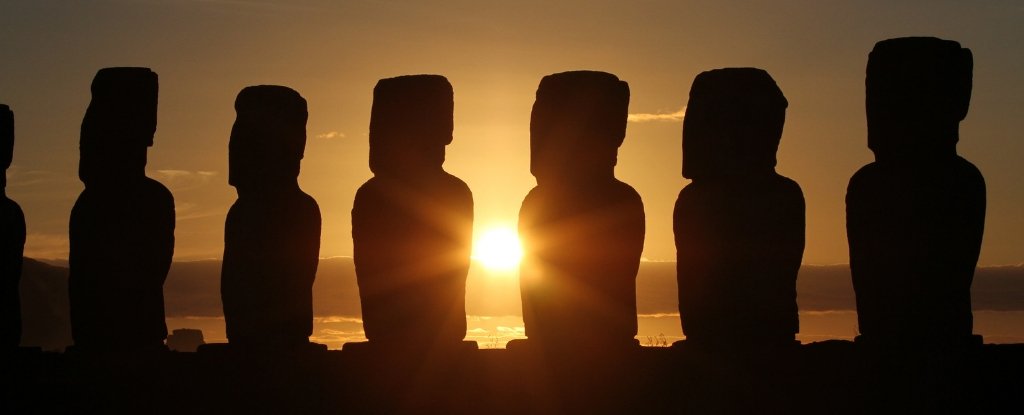Growing Evidence Says People on Easter Island
Were Still Okay When Europeans Landed

(Thomas Griggs/Unsplash)
CARLY CASSELLA 14 FEB 2020
The mystery of Rapa Nui, or Easter Island, is often told as a "parable of self-destruction", a cautionary tale of human exploitation and 'ecocide'. When the last tree falls, so does humanity - or so the story goes.
It's a narrative that's been repeated many times and is often treated as fact, but in recent years, evidence has been mounting to suggest the people of Rapa Nui are incorrectly blamed for their own demise.
New research suggests these islanders were building platforms for the iconic Moai statues up until at least 1750, well beyond the society's hypothesised collapse around 1600 and up to and beyond the later arrival of foreign seafarers.
"The general thinking has been that the society that Europeans saw when they first showed up was one that had collapsed," says anthropologist Robert DiNapoli from the University of Orego.
"Our conclusion is that monument-building and investment were still important parts of their lives when these visitors arrived."
Radiocarbon dating on 11 of the island's 150 stone platforms - known locally as 'ahu' - has directly challenged traditional components of the collapse narrative.
Polynesians are thought to have first colonised Easter Island sometime between the late 12th and early 13th centuries; according to the new findings, construction on the stone monuments began roughly fifty years later.
Focusing on the few monuments with good chronological data, the authors claim between the mid 14th and 15th century, there was a rapid period of ahu construction, followed by a relatively slower period of construction through the 18th century.
In fact, one of the stone platforms analysed may have even been built as late as 1825, some 600 years after the island was first colonised.
While this is on the extreme end of the estimate, even if the general outline is right, it means Easter Islanders were putting in the time and effort to build these resource-expensive monuments long after their society is said to have collapsed.
"Easter Island's ancient society was sustainable despite limited resources and isolation," says anthropologist and archaeologist Terry Hunt from the University of Arizona.
"The islanders even continued their astonishing investments in monuments following the devastating impacts of European contact."
Historical records also support this idea. The first Dutch seafarers who arrived on the island in 1722 reported seeing locals carrying out rituals in front of the Moai statues, and in 1770, Spanish explorers witnessed something similar.
But then, a mere four years later, when British explorer James Cook sailed ashore, he and his crew found the monuments overturned.
Today, the true reason for the collapse of the Rapa Nui society is hotly debated, but over the years some have conceded that Europeans may have played a role in the matter, or, at the very least, were responsible for "finishing it off".
As the palm trees disappeared, sustenance dwindled, and warfare broke out on Easter Island, the arrival of Europeans may have been the last straw.
Still, even in the beginning, this was hardly a clean and simple case of 'ecocide'. Recent research suggests the forests on Rapa Nui might have disappeared much quicker than we thought, too rapidly for humans to achieve on their own, and it might have had something to do with an influx of hungry misplaced rats.
And then, of course, there were other humans. Even in a remote corner of the Pacific, Rapa Nui were not safe from rodent stowaways or strangers.
In the 1800s, South American slave raids took away as much as half of the island's native population, and by 1877, following decades of disease, destruction and enforced migration, only 111 Rapa Nui remained.
"Once Europeans arrive on the island, there are many documented tragic events due to disease, murder, slave raiding and other conflicts," says anthropologist Carl Lipo from Binghamton University in New York.
"These events are entirely extrinsic to the islanders and have, undoubtedly, devastating effects."
In other words, the people of Rapa Nui may have been no more responsible for their own demise than any other indigenous society devastated by white settlers and explorers.
In light of accumulating evidence, both historical and physical, archaeologist Catrine Jarman from the University of Bristol claims Easter Island's societal collapse is not so much a mystery as it is a misconception.
"Perhaps, then, the takeaway from Rapa Nui should not be a story of ecocide and a Malthusian population collapse," she wrote for The Conversation in 2017.
"Instead, it should be a lesson in how sparse evidence, a fixation with 'mysteries', and a collective amnesia for historic atrocities caused a sustainable and surprisingly well-adapted population to be falsely blamed for their own demise."
The study was published in the Journal of Archaeological Science.
No comments:
Post a Comment